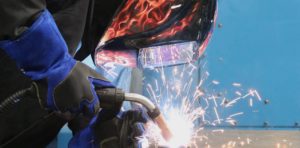How to Reduce MIG Gun Wear and Extend Gun Life
Understand the most common causes of gun wear and apply these tips to reduce downtime and optimize gun performance and longevity.
Posted: February 22, 2022
WELDING TIPS
Like any equipment in a welding operation, MIG guns are subject to routine wear and tear. The environment and the heat from the arc, along with other factors, impacts their longevity. When operators follow best practices for their use, however, most quality MIG welding guns can last at least one year in a manufacturing environment. Routine preventive maintenance can also help extend product life.
Knowing the common causes of MIG gun wear — and how to eliminate them — is a good step toward minimizing downtime and costs for addressing issues.
What Causes MIG Gun Wear?
The welding environment and application can affect MIG gun life. Some of the most common causes of gun wear include:
- Temperature changes: Extreme temperature fluctuations can affect the condition and expected life of the MIG gun jacket, which is typically a rubber-type composite material. If temperatures fluctuate from high to low, the jacket material will react differently — becoming softer or harder — which eventually leads to wear.
- Environmental damage: Whether you’re welding inside a facility or on an outdoor jobsite, dirty conditions can introduce abrasives and debris into the MIG gun circuit and consumables. Guns can also be damaged if they are dropped, run over, walked on, or caught in a lift arm or boom. These actions can damage the cable or cause disruption of the shielding gas flow. Welding on or near abrasive surfaces can cause cuts to the gun jacket or cable. It’s not recommended to weld with a MIG gun that has a damaged jacket. Always replace worn, damaged or cracked guns or cables.
- Lack of proper maintenance: When dirt and debris build up within the gun liner or on the contact tip, it increases resistance and causes additional heat buildup — the enemy of gun life. A wire feeder that isn’t feeding properly can also cause damage elsewhere in the gun.

A broken handle or noticeable chips or cuts in the gun jacket or cable are common indicators of MIG gun wear. But other signs aren’t always visible.
If a burnback, erratic arc or poor-quality welds are an issue during welding, these could be caused by inconsistent power being delivered to the weld circuit. Worn connections or components in the welding gun can cause these power fluctuations. To avoid downtime and additional wear on the gun, it is important to troubleshoot weld or arc issues and fix them as quickly as possible.
Tips for Preventing MIG Gun Wear
Consider these five tips to help optimize gun performance and longevity.
- Don’t exceed the duty cycle
Manufacturers have the option of rating their guns at 100%, 60% or 35% duty cycle. Duty cycle is the amount of arc-on time within a 10-minute period. Exceeding the gun’s rating can result in excess heat that wears gun components more rapidly and can potentially damage them to the point of failure. If an operator feels the need to increase parameter settings to achieve the same weld they previously completed, this could be a sign that the gun has begun to fail, or something is wrong with the weld circuit.
- Use a quality jacket cover
To protect the cable from gashes or sharp objects in the welding environment, use a gun jacket cover made from a material that offers a higher abrasion resistance. Jacket covers are available in various lengths to suit many gun styles and sizes. Be sure to replace the jacket as needed for maximum protection.
- Check consumable connections
Any loose connection in a weld circuit will increase heat and resistance, which in turn will increase wear on the gun and components. When changing consumables, be sure threads are clean and tight. Inspect the gun regularly, tightening any loose connection — whether it’s the diffuser, neck or contact tip — because loose connections inhibit power transfer within the circuit for the weld. It’s also important to check all connections after servicing the gun or changing consumables.
- Properly manage the cable
The best condition for any weld cable and gun is to keep them as straight as possible during use. This provides better wire feeding and power transfer down the length of the gun. Avoid kinking the cable or using a gun and cable that are too long for the space. When the gun isn’t in use, be sure to coil the cable properly and keep the gun and cable off the floor or ground and out of harm’s way — ideally on a hook or shelf. Keep guns out of heavy traffic areas where they could be run over or damaged. Also, if the gun is on a boom, don’t pull the gun cable to move the boom or cart. This can damage the connections and wear them down faster.
- Conduct preventive maintenance
General maintenance and upkeep will help MIG guns perform as expected and prolong gun life. Pay attention to any signs of wear on the gun or consumables. Check all connections each time the gun is used and look for spatter buildup in the nozzle. Troubleshoot any gun or wire feeding issues as soon as possible. Also, be sure to use the correct parts when servicing or repairing a MIG gun. MIG gun manufacturers typically have a parts guide that indicates which parts go into a specific position on the gun. If the wrong parts are used, they will change the way power transfers through the gun as well as affect overall performance — and can increase wear over time.
Getting the most life out of your MIG welding gun involves numerous factors, from proper maintenance and care to using best practices when welding. Keeping an eye on MIG gun wear and changing consumables as necessary can help prolong gun life and deliver better performance.






